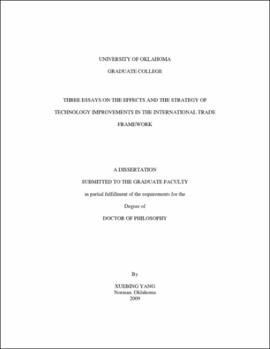| dc.contributor.advisor | Ju, Jiandong | |
| dc.creator | Yang, Xuebing | |
| dc.date.accessioned | 2019-04-27T21:26:15Z | |
| dc.date.available | 2019-04-27T21:26:15Z | |
| dc.date.issued | 2009 | |
| dc.identifier | 99193649602042 | |
| dc.identifier.uri | https://hdl.handle.net/11244/318689 | |
| dc.description.abstract | The main purpose of this study is to investigate the optimal strategy and the welfare effects of technology improvements in the open economy. The first essay, "Hicks Theorem: Effects of Technological Improvement in the Ricardian Model" studies these questions with the Ricardian model. The essay formally proves Hicks' (1953) insight into the effects of technological improvement: uniform technological improvement at home benefits all countries (or at least does not hurt); export-biased technological improvement at home benefits the foreign country (or at least does not hurt), but import-biased technological improvement at home can hurt the foreign country if the comparative advantage is not reversed. | |
| dc.description.abstract | The paper then studies optimal strategies of technological improvement and shows that for a small country it is optimal to choose export-biased technological improvement. For a large country, it is optimal to improve technology in both sectors at a rate proportional to the consumers' expenditure share. | |
| dc.description.abstract | The second essay, "A Two-Sector Eaton and Kortum Model: Technological Changes and International Trade" studies the effects of technological changes with a two-sector Eaton and Kortum model. This paper distinguishes two types of technology changes: changes in the technology levels (technology improvements) and changes in the dispersion of productivity of firms. The paper shows that technology improvements always increase the total trade. Technology improvements increase inter-industry trade if they originate in the comparative advantage sector, otherwise they decrease inter-industry trade. Increases in the degree of heterogeneity always increase the total trade and inter-industry trade. | |
| dc.description.abstract | The essay also analyzes the welfare effects of technology improvements and yields some new results. It shows that with the Cobb-Douglas utility function technology improvements are always beneficial to the innovator. In agreement with the literature, export-biased improvements benefit the foreign country. In a departure from the literature, however, the paper shows that import-biased improvements could benefit the foreign country. The essay also shows that when the final goods are complements, immiserizing growth may occur. | |
| dc.description.abstract | The theoretical model of the paper shows that the net exports of the comparative advantage sector are positive while those of the other sector are negative. This offers us a testable hypothesis about the Ricardian trade model. Using the OECD STAN databases, the paper conducts some simple tests concerning the prediction and finds strong support for it. The Ricardian model is one of the pillars of the international trade theory, but there have been few empirical tests of it. The results of this work will enrich the literature in this field. | |
| dc.description.abstract | The third essay, "Hicks Path: The Optimal Strategy of Technological Improvement in the open economy" extends the Eaton and Kortum framework into a multi-sector model to analyze the innovation pattern of countries. The model shows that the R&D activities are determined by sectoral expenditure and research efficiency. The model also shows that the laissez faire R&D input level is less than the socially optimal R&D input level in autarky when there are two sectors. In the open economy the R&D input in an industry depends on the country's advantage in the industry. | |
| dc.description.abstract | Using the OECD STAN database, the empirical analysis finds some support for Hicks' path, a technology improvement strategy for countries advanced by Hicks, but it also indicates that the R&D pattern in the real world might be richer than what Hicks predicted. | |
| dc.format.extent | 153 pages | |
| dc.format.medium | application.pdf | |
| dc.language | en_US | |
| dc.relation.requires | Adobe Acrobat Reader | |
| dc.subject | Technological innovations--Economic aspects | |
| dc.subject | Technology transfer--Economic aspects | |
| dc.title | THREE ESSAYS ON THE EFFECTS AND THE STRATEGY OF TECHNOLOGY IMPROVEMENTS IN THE INTERNATIONAL TRADE FRAMEWORK | |
| dc.type | text | |
| dc.type | document | |
| dc.thesis.degree | Ph.D. | |
| ou.group | College of Arts and Sciences::Department of Economics | |
